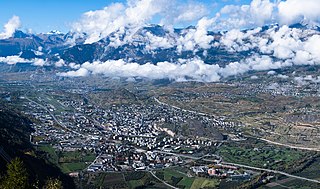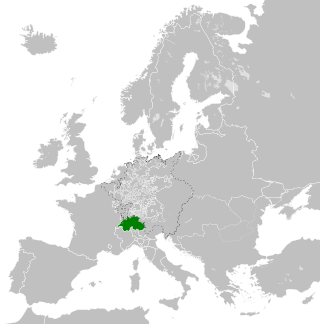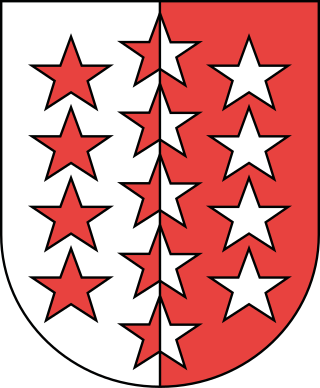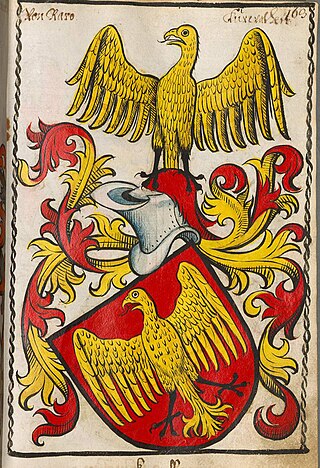
Valais, more formally, the Canton of Valais, is one of the 26 cantons forming the Swiss Confederation. It is composed of thirteen districts and its capital and largest city is Sion.

The canton of Bern, or Berne, is one of the 26 cantons forming the Swiss Confederation. Its capital city, Bern, is also the de facto capital of Switzerland. The bear is the heraldic symbol of the canton, displayed on a red-yellow background.

Sion is a Swiss town, a municipality, and the capital of the canton of Valais and of the district of Sion. As of December 2020 it had a population of 34,978.

The early history of Switzerland begins with the earliest settlements up to the beginning of Habsburg rule, which in 1291 gave rise to the independence movement in the central cantons of Uri, Schwyz, and Unterwalden and the growth of the Old Swiss Confederacy during the Late Middle Ages.

The Old Swiss Confederacy began as a late medieval alliance between the communities of the valleys in the Central Alps, at the time part of the Holy Roman Empire, to facilitate the management of common interests such as free trade and to ensure the peace along the important trade routes through the mountains. The Hohenstaufen emperors had granted these valleys reichsfrei status in the early 13th century. As reichsfrei regions, the cantons of Uri, Schwyz, and Unterwalden were under the direct authority of the emperor without any intermediate liege lords and thus were largely autonomous.

The Burgundian Wars (1474–1477) were a conflict between the Burgundian State and the Old Swiss Confederacy and its allies. Open war broke out in 1474, and the Duke of Burgundy, Charles the Bold, was defeated three times on the battlefield in the following years and was killed at the Battle of Nancy in 1477. The Duchy of Burgundy and several other Burgundian lands then became part of France, and the Burgundian Netherlands and Franche-Comté were inherited by Charles's daughter, Mary of Burgundy, and eventually passed to the House of Habsburg upon her death because of her marriage to Maximilian I, Holy Roman Emperor.

Romandy is the French-speaking historical and cultural region of Switzerland. In 2020, about 2 million people, or 22.8% of the Swiss population, lived in Romandy. The majority of the romand population lives in the western part of the country, especially the Arc Lémanique region along Lake Geneva, connecting Geneva, Vaud, and the Lower Valais.

The Diocese of Sion is a Latin Catholic ecclesiastical territory in the canton of Valais, Switzerland. It is the oldest bishopric in the country and one of the oldest north of the Alps. The history of the Bishops of Sion, of the Abbey of St. Maurice of Valais as a whole are inextricably intertwined.

The Old Swiss Confederacy, also known as Switzerland or the Swiss Confederacy, was a loose confederation of independent small states, initially within the Holy Roman Empire. It is the precursor of the modern state of Switzerland.

Jacques of Savoy, Count of Romont was a member of the House of Savoy and military commander during the Burgundian Wars.

The coat of arms of the Swiss canton of Valais is in red and white, divided vertically with thirteen five-pointed stars in opposite colours. The stars represent the thirteen districts. It was introduced in 1815, when the Valais was detached from the French Department of Simplon to join the join the Swiss Confederacy.

The Raron affair was a 15th-century rebellion in the Valais against the power of a local noble family, the Raron family. The rebellion brought several cantons of the Swiss Confederation into conflict with each other and threatened a civil war in the Confederation. While Bern was initially successful, they were eventually forced to surrender most of their gains.

The Republic of the Seven Tithings was a state in what is now the Swiss canton of Valais during the early modern period, and an associate of the Old Swiss Confederacy.

The Second Battle of Ulrichen was fought in 1419 between the Old Swiss Confederacy led by Bern and rebels from Valais near Ulrichen in the district of Goms in the canton of Valais in Switzerland. Negotiations after the battle led to the end of the Raron affair and self-determination for Valais.

Von Raron was an influential noble family in the Valais in the late medieval period.

The ruins of the Gestelnburg castle are situated above the village of Niedergesteln in Valais, Switzerland, on a rocky ridge called Feschti. The castle was probably built during the 12th century by the powerful Barons de la Tour, which are also called in German Herrn vom Turn. The rule of this family ended during the wars against the bishop of Sion in the second half of the 14th century, and the castle was finally destroyed by the Upper Valaisans in 1384. Exactly 600 years later, a project was started to restore the ruins and make them more easily accessible. Behind the castle there is a cave called Feschtiloch, which originates from the last ice age. The Gestelnburg is a Swiss cultural property of national importance.

Saillon Castle or Bayard Tower is a ruined castle in the municipality of Saillon of the Canton of Valais in Switzerland. It is a Swiss heritage site of national significance.

Saxon Castle is a ruined castle in the municipality of Saxon of the Canton of Valais in Switzerland.

Occupied since prehistoric times, the canton of Valais saw the rise of an exceptional civilization during the Bronze Age. From the 4th century BC, four Celtic tribes shared its territory, which was incorporated into the Roman Empire by Augustus. The Gallo-Roman Valais, located on the important Great St Bernard Pass, was prosperous. Christianity was first established in 377, and a bishopric was opened in Martigny by 381 at the latest.



















